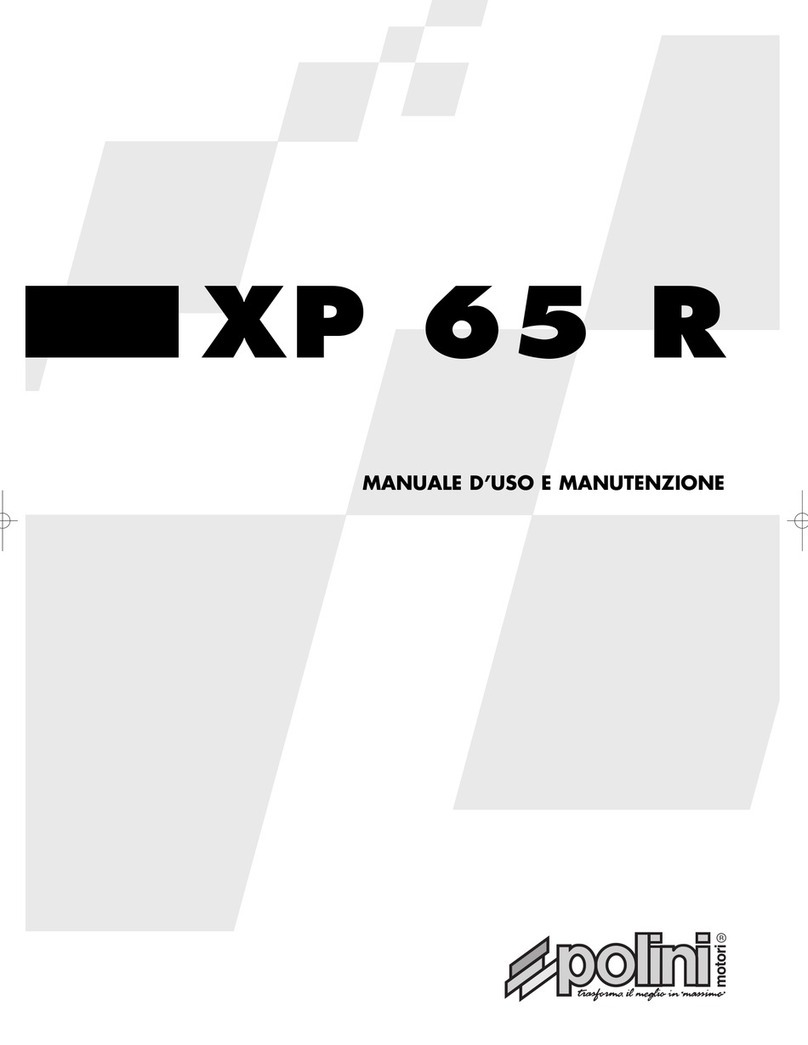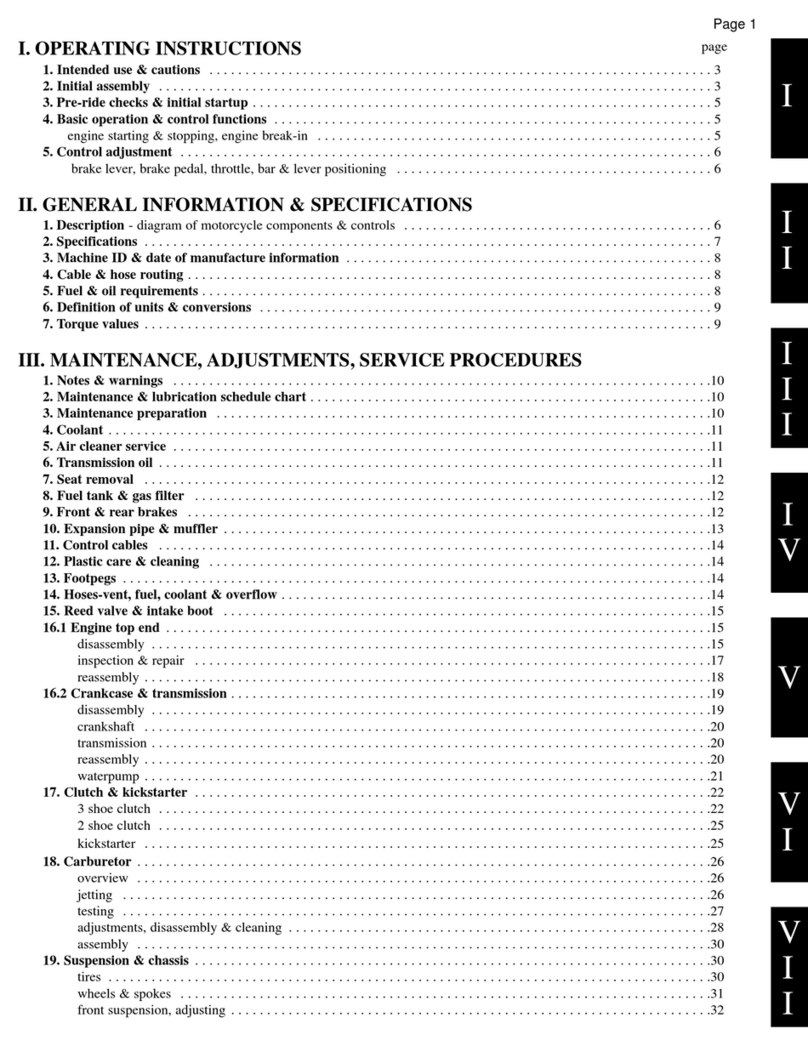FOREWORD
INSTRUCTIONS
MAY
BE
REPEATED A NUMBER OF TIMES
IN
THE COURSE OF THlS MANUAL.
THlS
HAS
BEEN
DONE PLIRPOSEFUUY
TO
EMPHASISE THE
IMPORTANCE
OF
CERTAIN OPERATIONS ANDTHE NEED
TO
BEAR SAFETY CONSTANTLY
IN
MIND.
ALL ENGINEMAINTENANCE MUST
BE
REFERRED
TO
A
SPECIALIST DEALER.
IMPORTANT
Read this manualcarefully throughout before ridingyour
new motorcycle.
This
manual contains importantinformationthat will help
you ovoid causing unnecessary damage to the machine and
serious or even fatal injuryto yourself to other persons and
things.
To ensure care-freeand satisfying oFfroad ridingyou must
get to know your new motorcycle thoroughlyand set it up
correctly beforeyou start riding.
IMPORTANT LEGAL NOTICE
THlS MOTORCYCLE
HAS BEEN
DESIGNEDAND
MANUFACTURED EXCLUSIVELY
FOR
COMPETITION USE
AND
IS
SOLD "AS
SEEN"
WlTH
NO
WARRANTY.
MIS
MOTORCYCLE DOES
NOT
COMPLY WlTH CERTAIN
ROAD SAFETY REGUIATIONSAND
IT
IS
THEREFORE
ILLEGAL TO RIDE
IT
ON
PUBLIC ROADS, HIGHWAYSAND
MOTORWAYS.
APPLICABLE LEGISLATIONPERMITS
THE
USE OF THIS
MOTORCYCLE
ONLY
IN
ORGANISED COMPETITIONS
OR
CLOSED TRACK
SPOR-I'ING
EVENTS ORGANISED
IN
COMPIJANCEWlTH LOCAL BY-LAWS.
ALWAYS ENSURE THAT
IT
IS
LEGAL
TO
OPERATE THE
MOTORCYCLE
BEFORE
RIDING
IT.
IT
IS
STRICTLY
FORBIDDEN
TO
CARRY PASSENGERS.
This
minicross motorcycle has been designed and
manufacturedfor use byone rider only.
NOTE
Childrenmust always be supervised by an adult when riding
this motorcycle.
READ THlS MANUAL CAREFULLY.
A
CAUTION!
This
text identifies a risk of serious or even fatal
personal injury if the associated instructions are
not followed. The associated insh.uctions must
be
followed carefully to avoid damage to the
motorcycle.
WARNING!
This text identifies a risk of personal injuryor
damage to the motorcycle. The associated
instructionsmust
be
followed carefully to avoid
serious or fatal accidents.
This
manual
is
an integral part of the motorcycleandmust
accompany it
if
it
is
sold or transferred to
a
new owner or
keeper.
WELCOME NOTICE
Congratulations onyour choice of
a
Polini minicross
motorcycle. By purchasinga Polini motorcycleyou have
become one of
a
large Family of satisfied Polini motorcycle
owners and riders.
NOTE!
This Polini minicross is a high performance
competition motorcycle and incorporates the
latest motocross race technology. It must only
be
used in competitive racing by expert riders.
This
new Polini minicrossmodel has been designedto
prformas competitively as possible.
Motocross
is
nevertheless a physical sport and winning
requires more than iust a good motorcycle.
To achieve
good
resultsyou must be in
good
physical
condition and be a skilful motorcycle rider.
The best results are achieved
by
riders who exercise
reguladyto keep in peak physical
form
andwho practise
their motorcycling
skills
frequently.
The purposeof this manual
is
to help you get the greatest
satisfactionpssible from you new Polini minicross
motorcycle, both from the performanceof the machine itself
and from success incompetitions.
PERSONAL PROTECTIVE EQUIPMENT
1
-
Most deaths in motorcyclingare caused by head iniuries.
ALWAYS wear a helmet. Whenever possible, also wear a
visor or goggles, as well as protectiveboots, gloves and
clothes.
2-
the exhaust system becomes extremely hot duringuse
and may remain
so
for quite some time afterwards.
Do
not touch any partsof the exhaust system. Always
wear clothes that completely cover your legs.
3-
Do
not wear looseor flowing clothing.
This
can become
entangled inthe control levers, kick-start lever, footrests,
chain or wheels.
4-
Respect the environment.
A
DANGEROUS MODIFICATIONS
MODIFICATIONSTO OR THE REMOVAL OF
ORIGINAL PARTS FROM THlS MINICROSS
MOTORCYCLE MAY CAUSE IT TO BECOME UNSAFE
OR ILLEGAL
ALWAYS COMPLY WlTH ALL LOCAL AND
NATIONAL LAWS, REGULATIONS AND SAFETY
STANDARDS.
THIS MOTORCYCLE HAS BEEN PROJECTED FOR A
DRIVER UNDER A WEIGHT OF
85
Kgs.






























